Patient Simulator Market Research, 2032
The global patient simulator market size was valued at $530.3 million in 2022, and is projected to reach $1,221.83 million by 2032, growing at a CAGR of 8.7% from 2023 to 2032. Patient simulators are mannequins that mimic the physiology and responses of a human patient. These simulators are commonly used in healthcare education to provide students and healthcare professionals with a realistic training environment that replicates clinical scenarios. Patient simulators can simulate a wide range of medical conditions, allowing learners to practice diagnostic, therapeutic, and decision-making skills in a safe and controlled setting. Thus, they are an effective tool for improving the quality and safety of patient care by helping to prepare healthcare professionals for real-world situations.
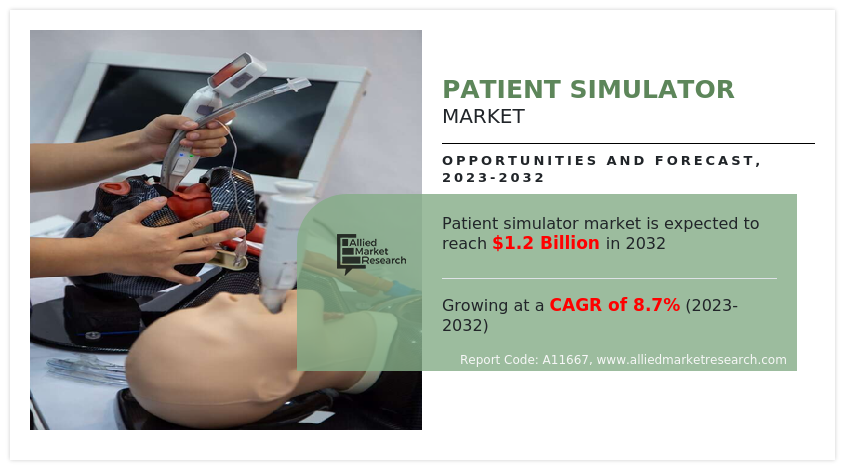
Market Dynamics
The major factor driving the patient simulator market is the growth in focus on patient safety, which is attributed to rise in incidences of medical errors. For instance, according to World Health Organization (WHO), globally, 4 in 10 patients are harmed in primary and outpatient health care. The most detrimental errors are related to diagnosis, prescription, and the use of medicines. Thus, rise in incidences of medical errors is anticipated to drive demand for simulation based training, thereby driving the growth of the patient simulator market size.
Furthermore, strong presence of key players manufacturing advanced simulators technologies and increase in initiatives by players in organizing training programs for healthcare professionals are anticipated to drive the growth of the patient simulator market share. In addition, rise in initiatives taken by various government organizations regarding reducing the prevalence of medical errors and improving the skills of healthcare professional are anticipated to potentially drive the market growth.
In addition, technological advancement is another factor driving the growth of the patient simulator market share. With the healthcare industry becoming increasingly reliant on technology, there is a surge in demand for simulation tools that incorporate the latest technologies, such as development of virtual reality (VR) and augmented reality (AR) simulators. Further, the use of advanced software and hardware systems to enhance the learning experience for healthcare professionals potentially drives the market growth.
Moreover, presence of healthcare institutions, including hospitals, clinics, and medical schools using patient simulators to train healthcare professionals, including doctors, nurses, and paramedics further drives the patient simulator market growth. In addition , the governments’ guidelines on incorporation of simulation based education and training in the curriculum further potentially augments the market growth.
Furthermore, rise in prevalence of chronic diseases, which requires more skilled professional for the diagnosis and treatment of the condition is anticipated to drive the market growth. In addition, the rise in popularity for minimally invasive surgeries owing to its advantages demands highly skilled and experienced professionals, thus driving the market growth. Furthermore, according to World Health Organization (WHO) report, significant complications during or after surgery are still common, accounting to 7 million patients annually, resulting in increase in morbidity and mortality rate. Thus, such cases have boosted the demand for simulation based training, therefore driving the market growth.
Moreover, the global patient simulator market has witnessed notable growth due to increased expenditure on healthcare. With growth in healthcare industry, there is increase in focus on improving the quality of care and reducing the incidence of medical errors. This has led to an increased demand for efficient and advanced solutions for training professionals such as patient simulators.
However, initial cost of purchasing simulators can be higher, particularly for smaller facilities, thus restraining the market growth. In addition to the initial cost, there are expenses associated with maintaining and upgrading the system, such as software updates, repairs, and training for healthcare professionals. Furthermore, in developing countries, less funding is anticipated to limit the adoption of simulators by medical institutes thus, restraining the growth of market.
The outbreak of COVID-19 had a positive effect on the market expansion for patient simulators. This is attributed to adoption of simulators in medical training and has led to the development of new types of simulators that allow more flexible and remote training. In addition, according to an article published in National Library of Medicine, in 2020, considering the benefits of simulation-based healthcare environments, medical school administrators and various government organizations invested in simulation-based educational management technologies and products to keep the clinical education and competency assessment on track throughout the COVID-19 pandemic. Consequently, COVID-19 had a positive effect on the patient simulator market.
Segmental Overview
The patient simulator market is segmented on the basis of product type, technology, end user, and region. By product type, the human patient simulator market is categorized into adult patient simulator, infant simulator, and childbirth simulator. On the basis of technology, it is segregated into high-fidelity simulators, medium-fidelity simulators and low-fidelity simulators. Depending on end user, it is fragmented into hospitals and academic institutions. Region wise, the human patient simulator market is analyzed across North America (the U.S., Canada, and Mexico), Europe (Germany, France, the UK, Italy, Spain, and rest of Europe), Asia-Pacific (Japan, China, Australia, India, South Korea, and rest of Asia-Pacific), and LAMEA (Brazil, South Africa, Saudi Arabia, and rest of LAMEA).
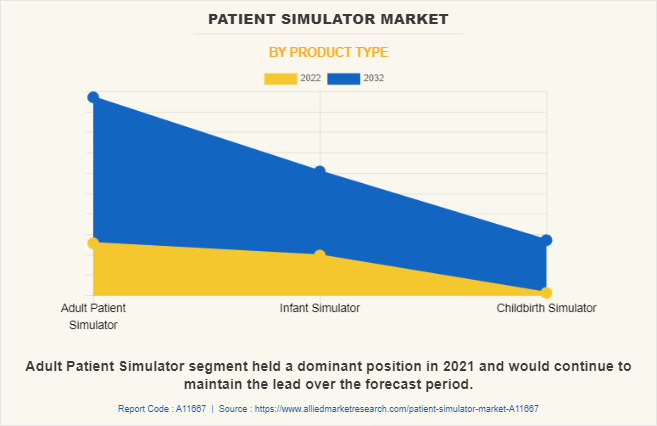
By Product Type
By product type, the adult patient simulator segment accounted for the largest share in 2022 and is expected to remain dominant during the patient simulator market forecast period, owing to rise in number of adult population suffering from chronic diseases, which demands advanced simulators that allow immersive and realistic simulation experience. Furthermore, there is rise in number of key players offering such advanced adult patient simulator system.
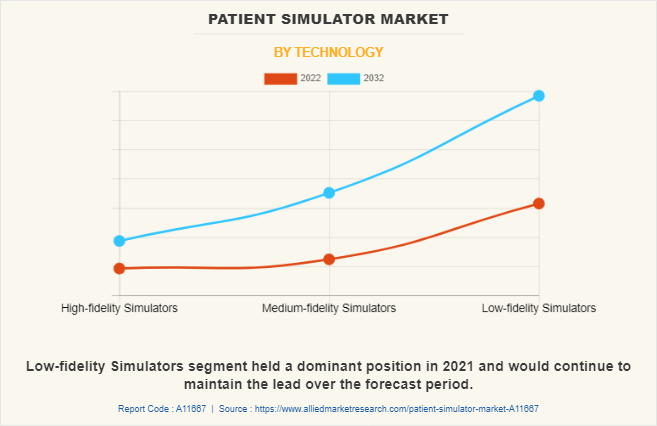
By Technology
On the basis of technology, The Low-fidelity Simulators segment occupied highest share in 2022 owing to the affordable cost of the systems, increase in awareness of simulation-based training programs and rise in number of healthcare institutes. However, Medium-fidelity Simulator is projected to register fastest CAGR during the forecast period, owing to its advantages such as flexible and versatile training tools that can provide a realistic and customizable training experience. Furthermore, affordable cost is driving the segment growth.
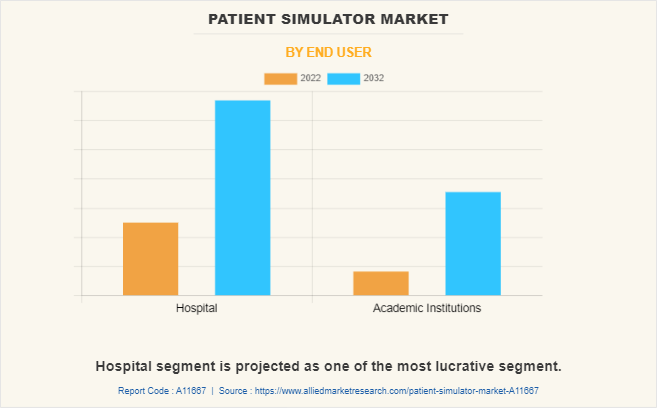
By End User
Depending on end user, the patient simulator industry is categorized into hospitals and academic institutions. The Hospital segment occupied largest share in 2022, owing to increase in demand of skilled healthcare professionals and increase in awareness regarding patient safety. However, the academic institutions segment is projected to manifest the fastest CAGR from 2023 to 2032, owing to rise in funding & grants for simulation labs and training programs, surge in availability of wide range of simulators depending upon the diseased condition.
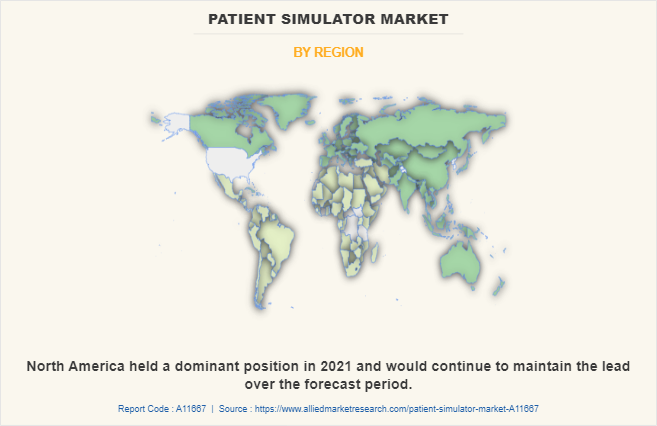
By Region
Region wise, North America accounted for the largest share in terms of revenue in 2022, owing to rise in focus on patient safety, growth in demand for minimally invasive surgeries that require skilled professionals, technological advancement, and strong presence of key players with established distribution channels. However, Asia-Pacific is anticipated to witness notable growth owing to rise in government initiatives to improve healthcare infrastructure, increase in demand for skilled healthcare professionals, and surge in chronic diseased conditions that require surgeries.
Presence of several major players such as CAE Inc., Mentice AB, Surgical Science Sweden AB, and Laerdal Medical and advancement in manufacturing technology for development of simulators in the region are expected to drive the growth of market. Furthermore, presence of healthcare infrastructures such as medical institutes & hospitals and rise in adoption rate of simulation based training are expected to drive the patient simulator industry growth. Furthermore, various collaborations and contract agreements as key strategies adopted by the key players in this region boost the growth of the healthcare simulation market.
Asia-Pacific is expected to grow at the highest rate during the forecast period. The market growth in this region is attributable to rise in incidence of patient harm cases owing to less skilled healthcare professionals, thus resulting in demand for primary care services that focus on preventing medical errors in diagnosis and treatment. For instance, according to World Health organization (WHO), each year, 134 million adverse events occur in hospitals in low- and middle-income countries (LMICs) due to unsafe care. This, in turn, has driven the demand for simulation based training, thereby boosting the patient simulator market in this region.
Moreover, the region has become a hub for patient simulators owing to rise in geriatric population base, diverse patient pool, and relatively lower costs of training programs compared to developed countries.
Furthermore, rise in R&D activities as well as well-established presence of domestic companies in the region are expected to provide notable opportunities for medical simulation market growth. In addition, rise in contract manufacturing organizations within the region is expected to provide lucrative opportunities for new entrants in this region.
Competition Analysis
Competitive analysis and profiles of the major players in the patient simulator market such as CAE Inc., Gaumard Scientific, Mentice AB, Surgical Science Sweden AB, Kyoto Kagaku Co., Ltd., Laerdal Medical, MedVision, MEDICAL-X., Simulab Corporation, and Limbs & Things LTD. are provided in this report. Major players have adopted acquisition, development, joint venture, and collaboration as key developmental strategies to improve the product portfolio in the medical simulation market.
Recent Acquisition in Patient Simulator Market
In October 2020, Mentice AB , announced acquisition of the New York-based medical technology company Vascular Simulations (VSI), a world-leading provider of replication solutions. This acquisition is expected to allow endovascular procedures to be performed by doctors manipulating real medical devices within a physical 3D structure that replicates the vessel structure of the human body.
In July 2021, CAE Inc announced the acquisition of Medicor Lab Inc. (Medicor), a company which specializes in task trainer and realistic synthetic skin production. This acquisition augments portfolio of products and expands capabilities to offer improved quality simulators for a better customer experience.
Recent Collaboration in Patient Simulator Market
In December 2022, Surgical Science Collaborated with European Association of Cardiovascular Imaging (EACVI) to create a unique TOE online simulator, aiming to evaluate TOE knowledge and performance level among young cardiologists and assess the need for simulation training for this purpose.
In November 2022, Surgical Science announced a collaboration with the American Society for Gastrointestinal Endoscopy (ASGE) to develop new gastrointestinal endoscopy (GI) endoscopic simulation-based training and curricula for GI fellows and advanced fellows, as well as general and advanced endoscopists.
Recent Development in Patient Simulator Market
In January 2020, CAE Healthcare released CAE Vimedix 3.0, its updated ultrasound simulator with a new user interface that includes 3-D/4-D cardiac ultrasound for advanced assessment and diagnosis in preparation for ultrasound-guided interventions.
Recent Joint Venture in Patient Simulator Market
In July 2021, Surgical Science and Simbionix joined forces to deliver the future of medical simulation. The combination of the two VR simulation companies and their respective technologies gives a never been-seen chance to deliver the highest standard in training for medical professionals.
Key Benefits For Stakeholders
- This report provides a quantitative analysis of the market segments, current trends, estimations, and dynamics of the patient simulator market analysis from 2022 to 2032 to identify the prevailing patient simulator market opportunity.
- The market research is offered along with information related to key drivers, restraints, and opportunities.
- Porter's five forces analysis highlights the potency of buyers and suppliers to enable stakeholders make profit-oriented business decisions and strengthen their supplier-buyer network.
- In-depth analysis of the healthcare simulation market segmentation assists to determine the prevailing market opportunities.
- Major countries in each region are mapped according to their revenue contribution to the global patient simulator market.
- Market player positioning facilitates benchmarking and provides a clear understanding of the present position of the market players.
- The report includes the analysis of the regional as well as global patient simulator market trends, key players, market segments, application areas, and market growth strategies.
Patient Simulator Market Report Highlights
| Aspects | Details |
| Market Size By 2032 | USD 1.2 billion |
| Growth Rate | CAGR of 8.7% |
| Forecast period | 2022 - 2032 |
| Report Pages | 250 |
| By Technology |
|
| By End User |
|
| By Product Type |
|
| By Region |
|
| Key Market Players | Gaumard Scientific, MEDICAL-X, Mentice AB, MedVision, Surgical Science Sweden AB, Kyoto Kagaku Co., Ltd., CAE Inc., Laerdal Medical, Simulab Corporation, Limbs & Things LTD |
Analyst Review
This section provides various opinions of top-level CXOs in the patient simulator market. According to the insights of CXOs, increase in demand for advanced patient simulators and rise in investments for development of realistic & cost-effective simulators, globally are expected to offer profitable opportunities for the expansion of the market. In addition, increase in awareness and surge in focus on implementing strategies to improve patient safety provide lucrative opportunity for market growth.
CXOs further added that rise in demand for healthcare professionals and regulatory requirements drive the demand for patient simulators. As the global population ages and healthcare needs become more complex, there is an upsurge in need for well-trained doctors, nurses, and other healthcare professionals. Moreover, regulatory requirements in the healthcare industry demand the use of patient simulators in training institutions to meet certain standards of training and certification. Furthermore, North America accounted for the largest share in terms of revenue in 2022 owing to presence of large number of healthcare facilities, rise in chronic diseases conditions, and increase in number of key players offering patient simulators. However, Asia-Pacific is anticipated to witness notable growth owing to increase in demand for minimally invasive interventional procedures and technological advancement.
The major factor that fuels the growth of the patient simulator market are rising focus on patient safety, technological advancements in simulators and increase in awareness of simulation education.
Training and education is the leading application of Patient Simulator Market.
North America is the largest regional market for Patient Simulator
The market value of Patient simulator market in 2032 is $1221.83 million.
Top companies such as CAE Inc., Gaumard Scientific, Surgical Science Sweden AB and Laerdal Medical, held a high market position in 2022. These key players held a high market postion owing to the strong geographical foothold in North America, Europe, Asia-Pacific, and LAMEA.
The adult patient simulator segment is the most influencing segment in patient simulator market owing to rise in number of adult populations suffering from chronic diseases, which demands advanced simulators that?allow immersive and realistic simulation experience. Furthermore, there is rise in number of key players offering such advanced adult patient simulator system.?
The total market value of patient simulator market is $530.26 million in 2022.
Loading Table Of Content...
Loading Research Methodology...



